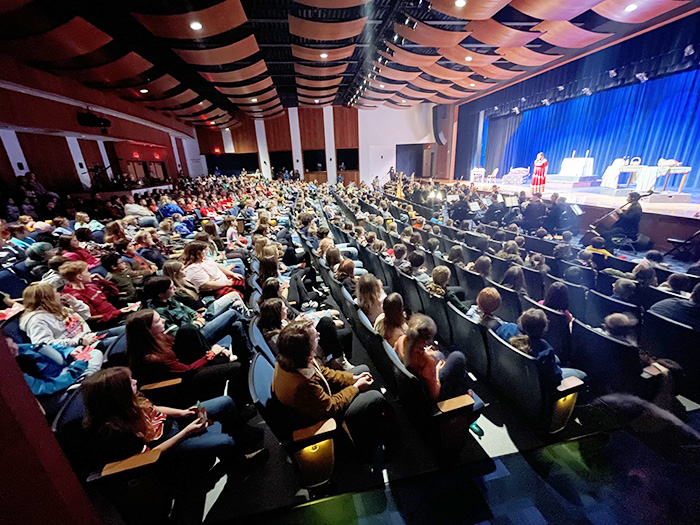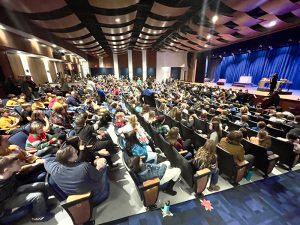By Cathy DeDe, Chronicle Managing Editor
What a wow!
More than 1,400 students from seven school districts attended three performances in one day of Lucinda and the Poinsettias, a children’s opera put on by the Glens Falls Symphony with singers from the Seagle Festival of Schroon Lake at the new state-of-the-art auditorium at Warrensburg Junior-Senior High School.

First: On the record, the emotional blast of excitement was palpable over this game-changing event on the parts of the Glens Falls Symphony Orchestra on one side, and the Warrensburg school district on another.
The two-part thrust:
Glens Falls Symphony makes a huge leap by expanding its educational programming and outreach for area students.
Warrensburg leverages a massive new auditorium project to create a performing arts “hub” for North Country school districts.
Nearly 470 elementary students from Queensbury and 50 from Lake George, 20 from The King’s School in Lake Luzerne, 80 students who travelled more than an hour on buses from Boquet Valley Central School in Elizabethtown, all 300 students of Ticonderoga Central School — and all 450 Warrensburg Central Elementary, Junior High and High School students — saw the show on Friday, Nov. 17.
The schools paid “nothing,” Symphony Executive Director Jennifer Brink tells The Chronicle. It was all funded through grants and donations. She said she hopes also to repay some of the schools’ travel costs after the finances are settled.
Rapt kids: The scene
The theater was chaos as students filed in from their buses for the 10:30 a.m. mid-morning performance. More students arrived than expected, forcing a rush to provide adequate seating.
Once that was achieved, Maestro Charles Peltz lifted his baton and the children were — no exaggeration — rapt. On the instant. Nearly no wiggles.
The 2016 opera, Lucinda y las Flores de la Nochebuena in Spanish, by Skidmore professor Evan Mack and librettist Joshua McGuire of Nashville, is a holiday fable based on Mexican tradition.
Not easy going: It is sung in Spanish and English, in operatic style that could make just the English tough to follow. It respects its young audience, introducing complex ideas and wordplay.
The kids had been prepped by the Symphony and their teachers. They knew the story and what to listen for. The piece wisely incorporates participatory elements; the students were eager to join in.

The outcome: 1,400 young lives touched, embracing what was obviously a memorable introduction for many to the experience of music, opera, theater — live performance.
This is ground-breaking for the Symphony, an instant success that was five years in the making, I was told.
Creative team members included Mr. Peltz, Ms. Brink, and Darren Woods and Richard Kagey of the Seagle Festival.
Originally hatched before Covid, they said the event was put on pause by the pandemic and thwarted several times along the way. Imagine the logistics of arranging, then re-arranging musicians, singers, production personnel, volunteers, buses, schedules and 1,400 kids from seven far-flung mostly rural towns.
Warrensburg’s theater
This was not possible, finally, without the showpiece theater that Warrensburg built.
Jim Corriveau, the school’s now-retired music and drama teacher who was in the audience also to observe, told me, “I had always envisioned this as a space for all of the upper county schools to share.”
The theater is built into the previous school cafetorium, a formerly industrial fluorescent-lit multi-purpose room with a small stage up in one corner, food service windows along the opposite wall.
That is all now gloriously unrecognizable, with a beautiful wide stage, elegant velvet curtain in Warrensburg blue, wood ceiling baffles and other elements that enhance sound and look good, and raked theatrical seating. Occupancy: 613.
A major project, it changes things not only for Warrensburg, but for these other schools that so clearly also reaped the benefit, and for producers such as the Glens Falls Symphony and Seagle Fest.
Copyright © 2023 Lone Oak Publishing Co., Inc. All Rights Reserved
 Glens Falls Chronicle Serving the Glens Falls/Lake George region; Warren, Washington and northern Saratoga counties since 1980
Glens Falls Chronicle Serving the Glens Falls/Lake George region; Warren, Washington and northern Saratoga counties since 1980

